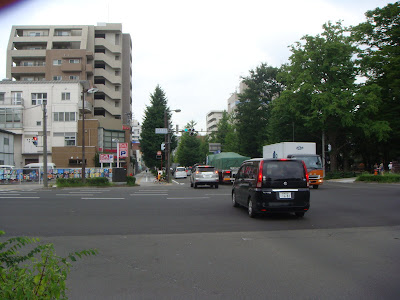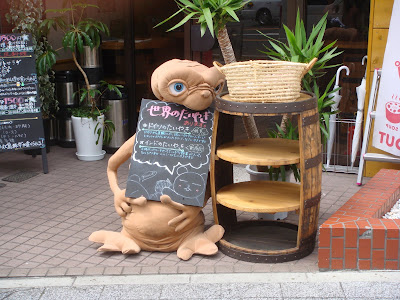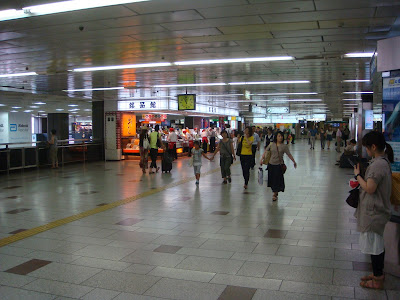Beginning at the beginning is usually a good idea, so I will start there. At six thirty on Aug 17, my wife, daughter, granddaughter, and I got into a taxi and headed for Sendai Station. We boarded the 7:20 Shinkansen for Tokyo and arrived there just under two hours later. I said goodbye to my family (they were going to my daughter's home in Kawasaki), changed platforms, and after about 20 minutes left for Kyoto aboard another Shinkansen. I arrived after a two and a half hour trip, during which I read a book about Buddhist Logic. I knew that I would have a half hour wait until my train on a local line departed, so I had lunch at a station restaurant and bought a snack for the trip. I decided to find the correct platform and wait there. I discovered that the train was already waiting and I was able to board and find a comfortable seat. While waiting, I ate my snack. As always with Japanese trains, it departed on time, and I found the 35-minute ride delightful. We passed through a series of tunnels that opened into narrow, steep-sided river valleys that were absolutely beautiful. We went straight across each on a bridge, entering the next tunnel almost immediately. One stations was actually on a bridge between the tunnels. I wanted to get out and draw the scenery.
At Sonobe Station, I got out and had to wait 20 minutes for a bus. It was very hot, a hint of things to come, so I found some shade and waited. The bus arrived on time. It was an easy 30 minute trip that ended at a depot, so there was no chance of my missing my stop. The depot was in the middle of a small town that was mostly one and two story private houses with a few shops scattered in between. The paperwork that I had received said that the Vipassana Center would automatically send a car for us.
At this point I should say that I will not have any pictures of my retreat. The paperwork had said that cameras were not allowed so I left my at home.
No car arrived, but there were some pretty young women with bags or backpacks standing around in the same area. A few quick questions and we discovered that we were all going to the center, so we chatted for the few more minutes elapsed before the car arrived.
For me, this is where the retreat actually started. The very pleasant man who was driving, put our bags in the back of the minibus. He put the women's bags on one side and the men's on the other. He then made separated us by sex so that the two men crowded into the front seat and the three women relaxed in the spacious two rows of back seats.
About 15 minutes later, we pulled off the narrow valley road onto a dirt road and arrived. The Center consisted of one large (about 15x45 meters) building, two two-story buildings with a one story section between them, and a one-story prefab building. There were also two other small one story buildings that turned out to contains showers, toilets, and clothes washing facilities (sinks, a spin dryer, and a covered hanging area).
As soon as the car stopped, the women were given their bags and herded around to the other side of the buildings. I had no further contact with them. I was given my bag and guided to the second floor of the building nearest the large one. It turned out to be the men's dining room, but it was also used for other purposes. Today it was going to be in-processing - men on the second floor and women on the first.
In-processing consisted of first filling out a form for the teacher. It was mostly about out meditative history and our willingness to follow the program. When I finished the form and turned it in, they gave me two cloth bags. I was to put my wallet in one and all of the things that I was not supposed to have in the other. They would keep these during the course and return them on the last morning. I put my wallet in one bag and my cell phone and the book on Buddhist logic in the other.
You will notice that I did not mention paying fees for the course. That is because it was completely free. There is no charge at all for room and board, nor for the instruction. At the end of the course they said they would ask for donations to support future students and to fund the expansion of the facility.
The list of things that we were not to have was quite impressive. We were not to keep reading or writing materials, tobacco, alcohol, drugs or religious objects of any kind. Actually there was a long list on a poster and basically you were to keep your clothes and toilet articles and give them everything else. I had not brought sheets or a pillow case, so I borrow them from the Center, paying them 500 yen in advance for the cleaning costs.
We were given a room number, the room where we would sleep, and a piece of paper with our name, course, and whether we were a 'new student' or an 'old student'. The paper had a piece of tape attached and were were told to put it on the headboard of our bed.
All of the bedrooms were in the largest building: women on one side and men on the other, with a large meditation room occupying a large part of the center of the second floor. I was in a room with six other men and we spent about an hour talking. We did not have to unpack because there was no place to put anything. We kept our clothes in our bags under our beds. Besides myself, there were two foreigners in the room. One an English teacher from Kobe, who was actually a professional musician but taught to feed himself and his family. The other was a man from Nepal. One of the remaining Japanese was apparently around sixty and the rest were in their 20s or early 30s.
We chatted for a while and then the gong rang for the evening meal. On this one day they actually served a regular meal, vegetarian of course, but a full meal. After the meal, we were told to report to the meditation room in the center of the second floor. We returned to our rooms and out getting to know each other chatting. At 7 p.m., the gong rang again and we all filed up the stairs to the mediation room for our orientation, the actual start of the course.
[I will continue from here tomorrow.]





















































